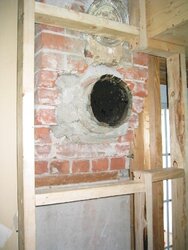So, after having made the 8 hour round trip from the Woodstock Soap Stone Company, I am anxious to get everything installed. Here's the situation:
My house was built circa 1890. It's a brick Victorian - not stick-framed, actually solid brick. The orginal chimneys were brick and on the inside of the house. At some point, one owner had a new, clay-lined, exterior chimney installed. The new chimney opening is below the original and has a 26" horizontal "run" from the interior of the house to the vertical part of the chimney. This horizontal section is clay set in mortar and is lined with single wall steel pipe - 8" in diameter. The steel liner protudes about 3" into the interior of the house.
I am/have been adding 2x4" stud walls to the interior, as there were none (and very little insulation). I have rough framed a stud wall in front of the opening. There is approximately 1" of space from the brick surface surrounding this 3" flange to the back side of the 2x4" studs.
My intention is to immediately reduce this 8" flange down to 6", pass through a Saf-T Thimble, and then continue with 6" single wall pipe to my new stove.
I have 2 concerns:
1) I don't think I'm doing anything wrong, but I would certainly appreciate any critiques of my plan. It's early enough in the project (not to mention, it's July) that I can make changes.
2) The instructions for the thimble include drilling through the masonry and attaching the thimble to it through 2 flanges located on the top and bottom of the thimble. The interior surface of the masonry surrounding my chimney is not conducive to this. the bricks "fall away" from the bottom of the clay liner. How could I deal with this situtation?
Many thanks.
My house was built circa 1890. It's a brick Victorian - not stick-framed, actually solid brick. The orginal chimneys were brick and on the inside of the house. At some point, one owner had a new, clay-lined, exterior chimney installed. The new chimney opening is below the original and has a 26" horizontal "run" from the interior of the house to the vertical part of the chimney. This horizontal section is clay set in mortar and is lined with single wall steel pipe - 8" in diameter. The steel liner protudes about 3" into the interior of the house.
I am/have been adding 2x4" stud walls to the interior, as there were none (and very little insulation). I have rough framed a stud wall in front of the opening. There is approximately 1" of space from the brick surface surrounding this 3" flange to the back side of the 2x4" studs.
My intention is to immediately reduce this 8" flange down to 6", pass through a Saf-T Thimble, and then continue with 6" single wall pipe to my new stove.
I have 2 concerns:
1) I don't think I'm doing anything wrong, but I would certainly appreciate any critiques of my plan. It's early enough in the project (not to mention, it's July) that I can make changes.
2) The instructions for the thimble include drilling through the masonry and attaching the thimble to it through 2 flanges located on the top and bottom of the thimble. The interior surface of the masonry surrounding my chimney is not conducive to this. the bricks "fall away" from the bottom of the clay liner. How could I deal with this situtation?
Many thanks.


